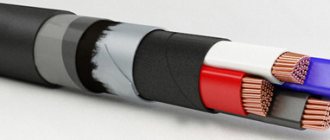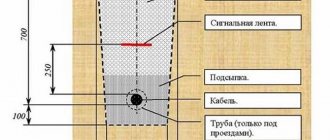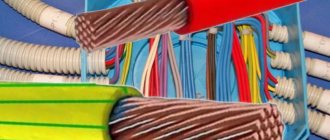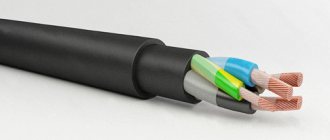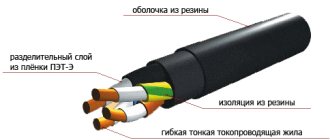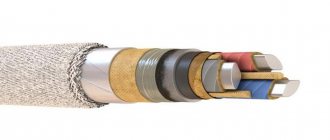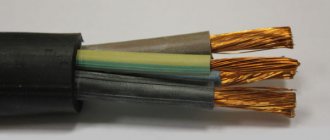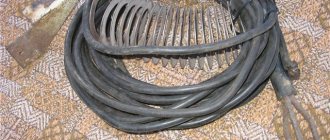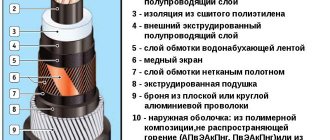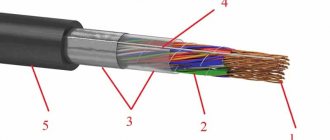When conducting an electrical network inside or outside a house, VVG cable or its variants are most often used. This is due to the good technical characteristics of such wires: they are excellent for stationary connections and can be used for alternating current circuits with voltages up to 1 thousand V. To make the right choice and not make mistakes, you should first understand how the VVG cable differs from VVGng, VVGngLS, VVG -png.
Source yadu.co.il
What is a power cable?
Even from school, we must remember that the electric current used to power all electrical appliances and equipment without exception is the ordered movement of charged particles (electrons). This phenomenon happens everywhere, but to use it on the current scale it is necessary to create certain conditions. First of all, this concerns the choice of shape, design, weight of the conductive medium, which will not only economically transfer power to consumers, but also safely.
The generally accepted cable form factor today is a multi-core conductor enclosed in protective insulation with a linear or concentric arrangement of conductors. Cable products are classified according to various criteria, but one of the most important is its functional purpose. If we are talking about the need to transmit electric current of industrial frequency and voltage, then use power cables, for example, VVG-KhL, VVG-Png, VVGng-HF, etc. In a narrower sense, this means interconnecting the input distribution device (IDU) , main switchboard) and the end consumer (industrial equipment, household appliances, lighting fixtures, etc.). The nature of the connection organization depends on the required operating conditions, cable weight, etc.
Life time
The estimated service life of VVG and NYM cables is at least 30 years.
At the same time, the wording “not less” means that if this cable is under 100% load in unfavorable conditions, it must work for AT LEAST 30 years.
And if there are the most ordinary conditions and the absence of a nominal load, then maybe all 50! It is these two main brands of cable, discussed in detail in the article, that are the most suitable and popular for installing electrical wiring, connecting sockets, switches and lighting.
There is another brand different from the two above that you may need in small quantities. But this is not a cable, but a wire - PV-3.
It is flexible, multi-core, easy to bend in small spaces and convenient to connect to machines via NShVI lugs. That is why it is used in the assembly of electrical panels.
Well, in the end, we will give a decoding of all the meanings of the letters in the cable brands, which are widely applicable in our electrical networks.
Marking and decoding
Each of the commercially produced cables may differ in the material of the cores, insulation, their number and additional elements.
This allows the manufacturer to develop products for specific operating conditions. To recognize them, appropriate markings are used. Its decoding can tell a lot about the components of the finished product, the presence of specific layers, for example, armored, the method of laying (by air, by ground, by frame, etc.), the number and cross-section of cores. Other indicators, for example, the weight of a linear meter of cable, are selected from the tables. With regards to the previously mentioned brands of power cables (and other similar products too), there is a layer-by-layer principle of organizing the designation, starting with the internal one. Accordingly, for VVG-KhL, VVG-Png, VVGng-HF, etc., the first letter must correspond to the material of the conductor. But here, according to the standards, there is one feature: this letter can be explicit or hidden (as in our case). If aluminum is used as the material for the core, then the symbol “A” appears at the beginning of the marking. If at first we see any other one (for example, for VVG-HL it is the symbol “B”), then this automatically means that the wire is copper. No other options are given in guidance documents and technical standards, since these materials today have virtually no alternative in mass production due to their physical characteristics. The specific gravity of these metals differs almost threefold, which means that a cable of the same length and cross-section with a copper core will weigh three times more than an aluminum one.
- B (first) - the conductive copper core has primary polyvinyl chloride (PVC) insulation. Depending on the purpose of the veins, its color may be different. For example, the phase wire may have brown insulation, the neutral wire may have blue insulation, the ground wire may have combined yellow-green insulation,
- B (second) - a shell of insulated conductors made of similar PVC,
- D – absence of a protective cover (outer shell). In electrical lexicon, this means that the cable is “bare.”
This is a complex of symbols that form the basic designation. Depending on the number and type of layers, it may be shorter or longer, that is, it will contain additional characters. For example, the symbol “B” will indicate the presence of an armored layer and the possibility of laying in the ground. Those coming after them indicate one or another modification, unique characteristics:
- HL – cold-resistant design of the cable, indicating that it is used under extreme temperature and humidity conditions,
- P – flat cable shape (individual cores are laid in the sheath not in a concentric, but in a linear way, in a row),
- ng – the materials used and their combination do not support combustion,
- HF – literally, translated from English, it means “halogen free”. In practice, this term does not apply to all chemical elements of group 17, but, by and large, only to chlorine. During combustion, such cables do not emit toxic chlorine-containing combustion products.
Manufacturers NYM
NYM cable is produced at foreign and domestic enterprises. The most popular factories in our country are:
- "Sevkabel";
- "Technoton";
- "Concord";
- "Pskovkabel";
- "Kamkabel".
Any products of these enterprises undergo all necessary stages of certification in accordance with international quality standards. For foreign companies, we will highlight the German TKD Kabel, Lapp Kabel and Helukabel, the French Nexans and the Turkish Denizli Cable.
NYM is stored and transported in special coils or drums, the diameter of which can be eight times the thickness of the cable itself. During storage, it is better to use a hard-to-reach and closed place, the minimum temperature of which is not lower than -15 degrees. Celsius. Also be sure to avoid direct exposure to direct sunlight.
VVG-HL
To transmit electric power at industrial voltages and frequencies at altitudes up to 4.3 km above sea level, special wires, such as VVG-KhL, are required. Available in both single-core and multi-core versions. In the latter case, the twisting method is used. The very shape of the VVG-KhL cores is either classic round or sector. The coloring of the internal PVC insulation is classic. Cables with a cross-section of more than 70 mm2 have a difference - digital marking is used here.
Separately, we should highlight the four-core VVG-HL cables, in which, unlike other modifications, the neutral and ground wires have a smaller cross-section.
As follows from the VVG-HL marking, the outer shell is made of cold-resistant PVC plastic. This allows the cable to be used in conditions of low temperature (up to -60ºС) and high humidity (up to 98%).
VVG-HL cables can be laid by air, in shafts, collectors, bridges, etc. It is not armored, so the possibility of mechanical damage should be minimized. Laying in the ground is not recommended. During installation, it must be taken into account that the minimum bending radii of single- and multi-core VVG-KhL wires are 10Dn and 7.5Dn, respectively.
Application area
NYM cable can be used in various climatic zones, inside production facilities with low or high humidity levels, in domestic and living rooms and even outdoors.
When installing outdoors, it is important to avoid direct exposure to ultraviolet rays of the sun. Inside residential buildings, wire is used in different cases: both with open and hidden wiring. It is used to switch lighting equipment, electrical sockets, switches and other devices. When installing a line in open ground, the cable must be protected using corrugated pipes or special boxes. When laid aerially, NYM is reinforced with high-quality overpasses. For any electrical devices that require a seal at the input, it is best to use just such a cable.
Differences in the field of application of cables according to fire hazard
The scope of application of cables for fire hazard is given in GOST 31565-2012 “Cable products. Fire safety requirements."
This GOST 31565 applies to cable products that are subject to fire safety requirements, intended for installation in buildings and structures, and establishes classification, fire safety requirements, and preferred areas of application. GOST 31565 does not apply to cable products intended for installation in land and water, as well as to oil-filled cables, winding and bare wires.
Let us highlight the main differences in the use of VVG, VVGng(A) and VVGng(A)-LS cables in accordance with GOST 31565.
According to Table 2 of Section 6 “Preferential areas of application of cable products, taking into account their type of execution”:
| Type of cable product | Fire hazard class | Preferred area of application |
| Without designation | O1.8.2.5.4 | For single installation in cable structures and industrial premises. Group installation is permitted only in outdoor electrical installations and industrial premises, where only periodic presence of maintenance personnel is possible, and passive fire protection must be used |
| ng(A) | P1b.8.2.5.4 | For laying, taking into account the volume of flammable load of cables, in open cable structures (overpasses, galleries) of external electrical installations |
| ng(A)-LS | P1b.8.2.2.2 | For laying, taking into account the volume of flammable load of cables, in internal electrical installations, as well as in buildings, structures and closed cable structures |
Brief explanation of VVG cable markings in the video:
Color of conductors in the cable according to PUE 7, GOST R 50462 and GOST 31996
Requirements for cables according to PUE
Cables VVG 3x1.5 and 3x2.5 requirements for cores according to GOST and TU
VVG-Png
This type of conductor product is used in environments where the possibility of fire spread must be minimized. The prefix “ng” in the designation VVG-Png means that the materials used in its manufacture do not support combustion.
Voltage and frequency specifications are generally accepted and are 660/1000 V at 50 Hz. Conducting copper conductors have a round cross-section, but are laid not in a concentric way, but in a row, in one plane (“P”). Their number
Specifications
All technical data of the most used cable sections VVGng-LS, such as rated current, weight, resistance are presented in the tables below:
One important tip - even if you don’t yet have a grounding wire in your house and the system is TN-C and not TN-CS, still always buy only a three-core cable.
This way you won't have to redo all the wiring if you change your grounding system. Well, as a last resort, the third core will always remain a backup if a break occurs on the phase or neutral wire.
Analogues of VVGng-LS
VVGng-LS-P is flat, with a copper core, insulation and PVC sheath of reduced fire hazard. VVGzng with filling, with copper core, PVC insulation, PVC sheath of reduced flammability. VVGng-P is flat, with a copper core, PVC insulation, and a PVC sheath of reduced flammability. VVGz with filling, with copper core, insulation and PVC sheath. VVG-P is flat, with a copper core, insulation and PVC sheath. VVGng-FRLS with copper core, insulation and PVC sheath of reduced fire hazard. Fire resistant. VVGng with copper core, PVC insulation, PVC sheath of reduced flammability. VVG with copper core, insulation and PVC sheath.
Laying methods
The VVG cable can be used in the construction of various objects, as well as in underground trenches. The laying method directly depends on the specific purpose. The conductor can be laid on various surfaces consisting of non-combustible materials. These include concrete, plaster, brick or plaster. The VVG cable can be laid openly under a variety of suspended structures.
A prerequisite is the exclusion of any mechanical influences. If there is a possibility of damage to the conductor, you need to think about additional protection. Often, special channels, tubes, metal or corrugated hoses are used for this.
The most popular is the hidden method. It is often used in residential premises when the cable is laid under plaster. First you need to make grooves in the walls, and then treat the product with cement plaster. In such situations, the possibility of mechanical impacts is eliminated, so there is no need to use additional protection. The only exception is when the wire is laid in wooden buildings. This option can be used in structures made of fireproof materials, for example, in pipes.
There is no wire that can be laid underground without the use of special protective elements. This is due to the fact that the cable needs to be preserved for a long period, but it itself is not equipped with built-in protection. Because of this, certain elements of protection against mechanical damage are used. In most cases they are sealed boxes.
Open position
If you study the technical parameters of the cable, you can conclude that installation is allowed in surfaces made of difficult-to-flammable or non-flammable materials, for example brick, concrete, gypsum or plaster. In an open way, VVG wire can be laid under various suspended structures, such as cables and the like. In this case, the gasket must be very reliable.
Any mechanical influences should be excluded. If the cable may be damaged, additional protection must be provided. Usually, special channels, metal hoses, corrugated hoses or tubes are used for this purpose. Protection is installed if the open installation method is carried out on flammable objects, built, for example, from wood.
Hidden option
This installation method is the most popular and is used in residential premises. The wire is usually laid under the plaster. Until this point, grooves are made in the walls, and after that the cable is covered with plaster and cement. In this case, mechanical damage is excluded, and therefore there is no need to apply additional protection. The exception is when the cable is laid in wooden houses. Hidden gasket can be used in various fireproof materials, for example, in pipes.
Location underground
No type of cable can be laid underground without the use of special protection. This is because the wire needs to be preserved for a long time, but it itself is not equipped with built-in protection. That is why protective measures are taken against various mechanical damages. For underground installation, sealed boxes are used.
Difficulties during work
The wire must be transported carefully. Sudden movements can damage it. PVC sheathing can very quickly develop mechanical defects when in contact with sharp edges. The cord must not be twisted, bent or stored in a box.
Air laying
When purchasing a wire, you must take into account the presence of a protective grounding wire in the device. Because if it is not there, then during operation there may be a strong electric shock.
Do not connect copper and aluminum wires, otherwise they will oxidize very quickly.
The cross-section of the wire must correspond to the permitted load specified in the table. Failure to comply with this rule will result in heating and damage to the PVC sheath. The permitted voltage must be found in the specification. These rules cannot be ignored.
Classic parameters are necessary for those conditions when the insulating cable is laid in open areas (over the air). If it is installed in the soil, then it is advisable to recalculate its parameters.
Proper storage
It is forbidden to lay a current cable through channels that go deep underground. It won't bear the load.
The wire can function at different high temperatures, but the installation must take place at temperatures not lower than −13 degrees. The room also needs to be warmed up; if there is frost or precipitation outside, then work is prohibited. Due to the cold environment, the PVC shell layer can be damaged.
You also need to be mindful of the weight of the wire when installing it over the air. Multi-core VVGs per kilometer of distance can exceed the weight of 2-3 tons. Therefore, it is necessary to prepare the holding supports in advance.
